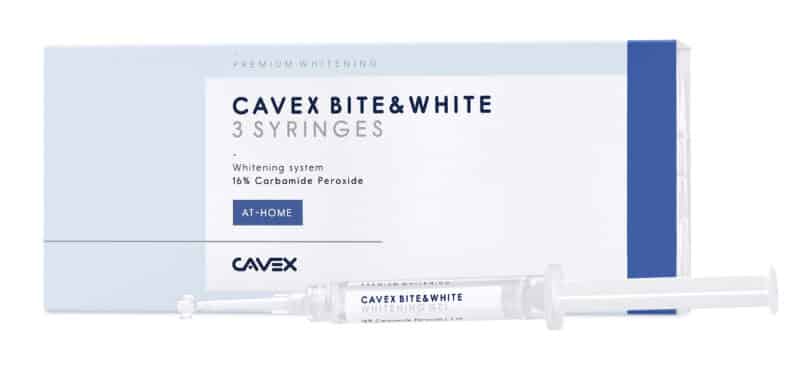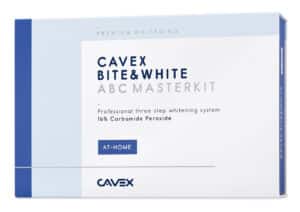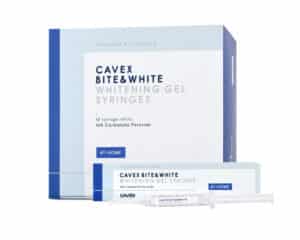Dealers
Users
General
Cavex Bite&White 3 Syringes
The compact, budget-friendly Cavex Bite&White 3 Syringes package contains three syringes with Cavex Bite&White whitening gel. The amount is sufficient for a 15-day whitening treatment. Cavex Bite&White 3 Syringes is the perfect solution to prolong whitening treatment or simply for a touch-up as well.
The thixotropic gel ensures that the teeth are covered with whitening gel evenly. Furthermore, the gel is prevented from coming into contact with the gums. Cavex Bite&White 3 Syringes is available with 16% carbamide peroxide (CP16= 6% hydrogen peroxide) for the European market. For other regions, the product is available with 22% carbamide peroxide (CP22= 9% hydrogen peroxide).
Due to the innovative composition of the Cavex solutions, a daily whitening session of 30 to 60 minutes already delivers outstanding results.
More information about this product? Download the brochure below. Visit our distributor’s page to discover where the product is available.
Features
- 3x 3 ml Cavex Bite&White whitening gel
- Thixotropic gel flows under pressure
- Prevents contact with the gums
- Whitening sessions of just 30 to 60 minutes per day
- Three-year shelf life (refrigerated)
- Convenient compact packaging
- Instruction manual included
Cavex Congress “Whitening shouldn’t be frightening”
In 2017 Cavex gathered the world’s most renowned dental specialist in the field of teeth whitening from all over the world for the congress ‘Whitening shouldn’t be frightening’. During this congress these specialists shared their view on the various available whitening solutions and techniques. Click here to read more.
-
Product Photos
-
Product Videos
-
Product Photos
-
Product Videos
-
FAQ
-
Instructions For Use
-
Documents
-
FAQ
-
How does tooth‐whitening work?
Discoloration of the teeth can have an intrinsic and/or an extrinsic cause. When the discoloration has an intrinsic cause, it means that there are small cracks in the enamel and dentin. Molecules within these cracks discolor, and that is what can be seen. Extrinsic means “from the outside” and these are the stains on the surface of the teeth.
The gel that is being used for Cavex Bite&White contains 16% carbamide peroxide. This proven whitening agent is able to penetrate enamel and break down the discolored molecules through the formation of radicals (small energy balls).
For the stains on the outside “extrinsic” part of the teeth, sometimes a whitening toothpaste would suffice. Using a direct whitening gel however would handle both intrinsic and extrinsic stains, being more thorough and therefore more effective. -
Is tooth‐whitening bad for the teeth?
Whitening should only be done under a dentist’s supervision. Tooth‐whitening under controlled dental office conditions is safe and effective. Clinical studies support the safety and effectiveness of home‐use bleaching gels when used appropriately. Tooth sensitivity and irritation to soft tissues can occur during bleaching treatment, but these effects only last for a short time. Cavex Bite&White has been developed and produced according strict European Cosmetic legislation and has undergone thorough testing and evaluation.
-
Where can Cavex Bite&White be bought?
In short, at the dentist and the dentist via a dental distributor. Cavex Bite&White should only be sold by a dentist. Before any whitening procedure, a consultation with a qualified dentist is recommended to ensure no underlying oral or health issues. According to the European Cosmetic Regulation 1223/2009, tooth whitening or bleaching products containing between 0.1 % and 6 % hydrogen peroxide (16% carbamide peroxide) can only be sold by dentists. Higher concentrations are not allowed to be sold within Europe.
The purpose of the law is twofold. On one hand, it is designed to reduce the risk of damage to tooth and gums that could result from the use of a tooth whitening product releasing more than 6% hydrogen peroxide. The law also intends to ensure that all tooth whitening procedures, performed with a significant amount of hydrogen peroxide released, are overseen by someone with the training and knowledge required to make sure the treatment is carried out safely and effectively. Cavex Bite&White is developed in full compliance with this new European legislation, and Cavex fully supports the enforcement of this law.Cavex Bite&White is ontwikkeld in volledige overeenstemming met deze Europese wetgeving, en Cavex staat volledig achter de handhaving van deze wet.
-
When should the tray(s) be placed in the mouth?
With Cavex Bite&White we recommend to whiten the teeth one‐and‐a‐half hour before sleeping Brush the teeth, put the bleach trays in, leave them in for 1 hour, rinse the mouth, wait 20 minutes, gently brush with fluoride tooth paste, sleep well.
While sleeping there is sufficient time for re‐mineralization after bleaching. It takes some time for the teeth to regain their initial strength.
Right after bleaching, your teeth are more sensitive to discoloration by foods or drinks. The structure of the teeth is “open”, so eating or drinking products (red wine, coffee, tea, soda, smoking…) that could stain are advised against. Anything that can stain a white t‐shirt can stain your teeth. While sleeping you don’t eat or drink, so there is no risk of staining. -
For how long should the tray stay in the mouth?
We advise to keep the tray in the mouth for one hour. The “active ingredient”, in the case of Bite&White is carbamide peroxide, needs about one hour to take full effect.
-
How many times should the procedure be repeated?
In the starter kit there are 2 syringes with gel. Both syringes should have enough material for 5 days, so 10 days period of whitening (upper and lower jaw) in total. If by this time the patient have reached his/her goal, great. If not, discuss possible prolongation of the treatment.
-
Does tooth whitening cause sensitivity to teeth or gums?
The well fitted tray, combined with the thixotropic whitening gel should ensure that the gel will not be in contact with the area’s which are sensitive for irritation like your gums. Cavex Bite&White contains potassium nitrate in the gel. This is a desensitizer, therefore minimizing sensitivity. Slight sensitivity is possible and differs from person to person. In this case a desensitizer like Cavex ExSense could help.
-
How much whiter will the teeth become?
We honestly cannot guarantee an exact indication except.. teeth will get whiter! The amount of shades lighter differs too much from person to person. It all depends on the nature and current state of the teeth, the type of measurements and the motivation(discipline) of the user. When the patient is not satisfied with the results after the 10 days of use, consult if it is possible to extend the treatment with an extra syringe of whitening gel.
-
For how long the gel/product be stored?
Like all products, Cavex Bite&White also has its expiration date. Cavex Bite&White can be stored for at least 3 years, but only when stored in the refrigerator.
-
What are the transport conditions of Cavex Bite&White products?
Transportation of Cavex Bite&White products based on carbamide peroxide does not require a conditioned environment. The products can be transported dry and without direct sunlight, at a temperature of up to 25 ° C, without any negative effects.
-
Tooth‐whitening at the dentist or at home, what is the difference?
There are two ways to effectively whiten teeth. One is the “fast” in-office treatment at a dentist, the other way is at home.
Chair‐side is mostly done with a “high peroxide gel and a light* in the dentist office. After the session the patient’s teeth will have undergone some degree of whitening.
The process of a take home system is slightly different. There are two ways. The dentist will have to take an impression, which will be used for making a custom-made tray. The patient will receive this tray together with the Cavex Bite&White peroxide gel. The patient takes it home and applies the gel in the tray and mouth his/herself. -
How should Cavex Bite&White be stored?
Always store the whitening gel in the refrigerator. This is because high temperatures cause activation of the peroxides in the gel, resulting in a less effective low concentrated gel.
-
Can teeth be whitened with restorations/crowns/facings on my tooth.
Whiten the teeth while having restorations is possible, however, these restorations won’t be affected by the whitening gel. A solution to this is to replace restorations after reaching the desired color. Always make these decisions together with the dentist!
-
Is tooth‐whitening safe?
Whitening should be done only under dentist supervision. Tooth‐whitening under controlled dental office conditions is safe and effective. One main reason why many tooth whitening gels are dangerous for the teeth is the pH‐value. Many whitening materials have a low pH, and go with the saying “no pain, no gain”. Teeth generally become more sensitive than before using these materials and enamel weakens. Cavex Bite&White is pH‐neutral, and therefore safe to use.
Clinical studies support the safety and effectiveness of home‐use bleaching gels when pH‐neutral and used appropriately. Tooth sensitivity and irritation to soft tissues can occur during bleaching treatment, but these effects only last for a short period of time -
Does Cavex Bite&White contain fluoride?
Yes, the gel used for the whitening treatment contains fluoride. Fluoride is a proven agent for early re‐mineralization and restoration of the micro‐hardness.
-
Are whitening procedures with lamps at a dentist more effective than at home without the lamps?
The claim of a lamp is that it accelerates the effect of the peroxide. However, literature does not prove the effectiveness of a lamp accelerated bleaching. High intensity of light could cause few degrees of temperature increase which result in faster decomposition of the peroxide. Numerous studies indicate that the faster the bleaching process the higher the reversal rate. Also, the heat from the light on your teeth for a long period of time is potentially dangerous to the pulp of the teeth. Cavex only believes in controlled and gradual whitening procedures with moderate peroxide amounts. These tend to have a low reversal rate, with significant less sensitivity and are gentle for the mouth and body, eliminating any risk.
-
Why is 6 % Hydrogen Peroxide the maximum percentage?
Based upon numerous studies the Scientific Committee on Consumer Products (SCCP) made in 2011 a safety evaluation on the use of hydrogen peroxide in oral hygiene products and tooth whitening products. As in many risk evaluations the SCCP used the Margin Of Safety (MOS) to determine the maximum concentration which can be considered as safe. The MOS is the ratio between the NOAEL (No‐Adverse‐Effect‐Level) determined in animals and the level to which humans may be exposed.
MOS values below 100 have been interpreted by the regulatory bodies as not safe.
Margin Of Safety = NOAEL (mg / kg bodyweight / day)
Exposure (mg / kg bodyweight / day)NOAEL for hydrogen peroxide:
A 100 days rat gavage study showed a significantly reduction of the plasma catalyst level at higher dosage. Based upon this study the NOAEL (No‐Adverse‐Effect‐Level) was stated at 20 mg/kg bw/day.
Estimated Daily Exposure (average 60 kg bodyweight):
Toothpaste = 480 mg/day containing 0.1% hydrogen peroxide
0.48 mg / 60 = 0.008 mg/kg bw/day MOS = 20/0.008 = 2500 = SAFE
Mouth‐rinses = 3000 mg/day containing 0.1% hydrogen peroxide
3 mg / 60 = 0.05 mg/kg bw/day MOS = 20/0.05 = 400 = SAFE
Tooth whitener = 200 mg gel / tray / day containing 6% hydrogen peroxide
12 mg / 60 = 0.2 mg/kg bw/day MOS = 20/0.2 = 100 = SAFE
Tooth whitener = 200 mg gel / tray / day containing 35% hydrogen peroxide
70 mg / 60 = 1.17 mg/kg bw/day MOS = 20/1.17 = 17 = NOT SAFEConclusion: Based upon the MOS evaluation the SCCP considered 6% hydrogen peroxide (16% Carbamide peroxide) to be the maximum allowed concentration.
References:
SCCP report 18/12/2007– on file -
How do white spots or stains on the teeth occur?
There are three things that could be going on.
1. Fluorosis. This is one of the reasons a whitening procedure is done under supervision of the dentist. A patient could have always had this but never noticed it before. Fluorosis is a developmental disturbance of dental enamel caused by excessive exposure to high concentrations of fluoride during tooth development, not by using whitening products.
2. The patient have had braces/brackets and started a whitening treatment right after removing them. The brackets have caused the enamel to decalcify, and these spots might be more sensitive. There are ways to remove the stains, but discuss this with the dentist.
3. The teeth are dehydrated. The patient have used a high‐peroxide gel for too long, and it dehydrated the teeth. Do not worry; these stains will clear after a few days. We call this the “Chicken bone‐effect”. Leave a chicken bone to dry for a couple of days and it will turn white. Put it in water and it will return to the original color. Chances of this happening with moderately dosed whitening gels, like Cavex Bite&White” are minimal. -
Why does the mouth starts to foam when using the whitening trays?
When this occurs there are a few possible explanations.
1. The patient has a bracket wire in the mouth. The peroxide reacts to this metal and starts to foam. The dentist should check for this when providing the whitening material.
2. There is some sour fluids (acid) in the mouth. The peroxide reacts to sour fluids, so try avoiding this by rinsing well after using sour mouthwashes etc. -
Is it safe to bleach during pregnancy or while breastfeeding?
It is recommended that pregnant women and breastfeeding women consult a doctor to determine whether this is advisable.
-
Assortment
-
Brochures
-
Product info
-
MSDS
-
Cases & Research
| Art. nr. | Description | Contents |
|---|---|---|
| BW007 | Cavex Bite&White 3 Syringes CP16 | 3x Syringe 3 ml CP16% |
| BW008 | Cavex Bite&White 3 Syringes | 3x Syringe 3 ml CP22% |
-
MSDS Cavex Bite&White 3 Syringes CP16
-
MSDS Cavex Bite&White 3 Syringes CP22







